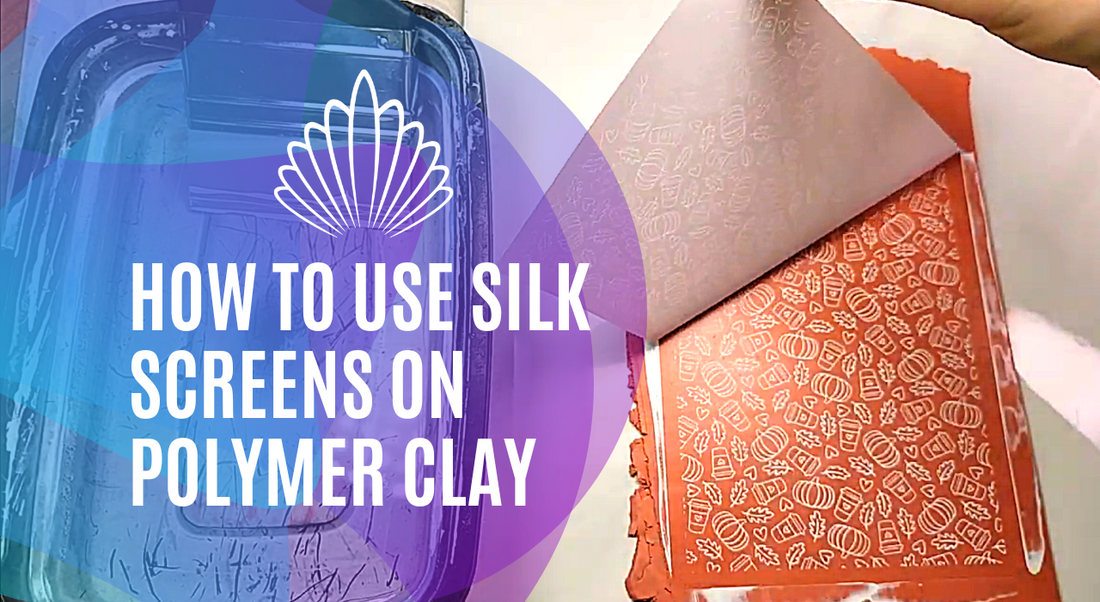
Using and Cleaning Silk Screens
Using your Silk Screen with Acrylic Paint
- Place your screen, shiny side down, onto a smooth uncured clay slab. The shiny side should feel smoother than the non-shiny side. The silk screens have a bit of a curl to them, and the shiny side will always be the concave side.
- Gently smooth the screen down onto the clay. It will naturally adhere to the sticky clay surface. Don’t press too hard. You don’t want the clay to push up into the screen mesh and get suck.
- Apply a line of medium to heavy body acrylic paint to one end of the screen. Use a card or squeegee to draw the paint across the surface of the screen. Again, don’t press too hard; this may cause the paint to scrape back up off the clay.
-
After completely covering your pattern with paint, it's crucial to act swiftly. Lift the edge of the screen to inspect the print. If you find the pattern isn't as saturated as you'd like or if there are blotchy or incomplete areas, you can enhance the print by peeling and relaying the screen.
Gently peel back about 50% of the screen from one corner, allowing the paint to fall through the mesh more effectively, then carefully lay it back down, smoothing it with your fingers. Repeat the process by peeling the opposite corner (e.g., bottom left and then top right) to ensure the entire screen has been lifted and relaid. This technique helps boost saturation and address any unevenness. If further adjustments are needed, you can reapply the paint, being careful not to press or scrape too hard. Once you're satisfied, peel off the screen entirely and admire your completed pattern! The paint will begin to dry on the screen almost immediately. Remember to work quickly!
Check out this video for an example of this technique: - Cut and cure your pieces, then seal that paint in with your favorite sealant.
- Some folks say that you don't need to seal in paint if you're applying it to uncured clay and then baking it on. I always seal because I don't want to risk the paint chipping or rubbing off. The best policy is to test it out yourself and do what you think is right for you!
Cleaning your Silk Screens
- After you peel your screen off your clay, immediately submerge the screen into a container of cool water and rub the paint off of it with your fingers or another similarly soft tool or brush. If you do not immediately clean your screen, the acrylic paint will dry in the mesh, and you won't be able to use your screen again.
- These screens are very durable but will crease if folded. Try not to crumple or crease the screen as you clean and dry it. Laying it flat in a sink or bason to rinse the paint away should be all that's necessary to clean the screen. Store your screens flat to avoid any creasing.
Using Your Silk Screen with Mica or Pigment Powders
Using powders on screens instead of paints is super fun because you can take your time coloring the different elements in the screen with different colors!
- Place your screen, shiny side down, onto a smooth uncured clay slab. The shiny side should feel smoother than the non-shiny side. The silk screens have a bit of a curl to them, and the shiny side will always be the concave side.
- Gently smooth the screen down with your fingers.
- Use powders to "paint" on your screen. You can use your finger or a paint brush.
- Gently brush off any excess powder before lifting your screen.
- When you lift your screen, make sure to do it carefully so you don't drop excess powder onto the clay.
- Lay a clean sheet of parchment paper over the pattern on your clay and use your hand to gently burnish the powder into the clay. This will help the pattern to stay put and not smear as easily. (It will still smear though, so be careful when handling your clay pieces until the powder is sealed in.)
- Cut and cure your pieces, then seal that powder in with your favorite sealant. Powders absolutely will rub off if you don't seal them in.
- My go-to is always UV resin when using mica powders. Other sealers don't cure as transparent and detract from the shine of the mica.
- To clean: scrub your screen gently with a soft brush and some water. The powder may stain the screen, but it won't affect its usability.
Tips and Tricks
- Paints may react differently depending on the paint and brand of clay you're using. Some clays and may remain tacky and never dry. Some may dry initially and then become tacky again a day later. Always test your acrylic paint on your clay before using screens.
- Let the paint dry fully on your clay before cutting shapes into the slab.
- You can clean the paint off of the sides of your pieces with a Q-tip and rubbing alcohol. Alternatively, the sides can be sanded after they're cured.
- Most acrylic paints can be removed from your scraps with rubbing alcohol.
- It is normal for the screens to stain. They will still be useable as long as the paint or powder is cleaned out of the mesh.
